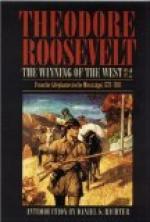The first retail store Kentucky had seen since Henderson’s, at Boonsborough, was closed in 1775, was established this year at the Falls; the goods were brought in wagons from Philadelphia to Pittsburg, and thence down the Ohio in flat-boats. The game had been all killed off in the immediate neighborhood of the town at the Falls, and Clark undertook to supply the inhabitants with meat, as a commercial speculation. Accordingly he made a contract with John Saunders, the hunter who had guided him on his march to the Illinois towns; the latter had presumably forgiven his chief for having threatened him with death when he lost the way. Clark was to furnish Saunders with three men, a packhorse, salt, and ammunition; while Saunders agreed to do his best and be “assiduously industrious” in hunting. Buffalo beef, bear’s meat, deer hams, and bear oil were the commodities most sought after. The meat was to be properly cured and salted in camp, and sent from time to time to the Falls, where Clark was to dispose of it in market, a third of the price going to Saunders. The hunting season was to last from November 1st to January 15th. [Footnote: Original agreement in Durrett MSS.; bound volume of “Papers Relating to G. R. Clark.” This particular agreement is for 1784; but apparently he entered into several such in different years.]
Thus the settlers could no longer always kill their own game; and there were churches, schools, mills, stores, race tracks, and markets in Kentucky.
CHAPTER VIII.
THE HOLSTON SETTLEMENTS, 1777-1779.
Organization of the Holston Settlements.




